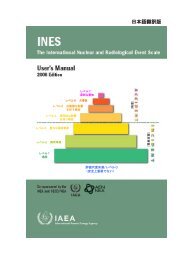Guidelines for Iodine Prophylaxis following Nuclear Accidents
Iodine_Prophylaxis_guide
Iodine_Prophylaxis_guide
Create successful ePaper yourself
Turn your PDF publications into a flip-book with our unique Google optimized e-Paper software.
<strong>Guidelines</strong> <strong>for</strong> iodine prophylaxis <strong>following</strong> nuclear accidents1999 updateconnection with thyroid disorders, such as auto-immune thyroiditis,Graves’ disease and nodular goitre. Such disorders are common in theadult population and in the elderly but relatively rare in children. Therisk of thyroid blocking in the newborn deserves special attention andis treated in more detail below.Side effects in other parts of the body, such as gastrointestinal effectsor hypersensitivity reactions, may occur but are generally mild andcan be considered of minor importance. Dermatitis herpeti<strong>for</strong>mis andhypocomplementaemic vasculitis entail an increased risk of severehypersensitivity reactions.The Polish experience, cited above in section 2.3, showed the risk ofsevere side effects from single doses of stable iodine to be minimal(less than 1 in 10 million in children and less than 1 in a million inadults). However, <strong>for</strong> repeated doses, there is no direct humanexperience that can be used <strong>for</strong> reliable numerical estimation of sideeffects.3.3 Consideration of exposed population groupsExposed population groups differ markedly in their risk of radiationinduced thyroid cancer from a given radiation dose. Neonates, infantsand small children are the most sensitive groups. The risk of sideeffects from stable iodine prophylaxis is also different, albeit generallysmall in the light of the latest experience. Because of these differencesit is important to consider potentially exposed population groupsseparately when deciding on plans <strong>for</strong> stable iodine prophylaxis.In general, the potential benefit of iodine prophylaxis will be greaterin the young, firstly because the small size of the thyroid means that ahigher radiation dose is accumulated per unit intake of radioactiveiodine. Secondly, the thyroid of the fetus, neonate and young infanthas a higher yearly thyroid cancer risk per unit dose than the thyroidof an adult and, thirdly, the young will have a longer time span <strong>for</strong> theexpression of the increased cancer risk.Individual radiation doses will also differ markedly within anyexposed group. The intake of radioactive iodine through inhalation8






